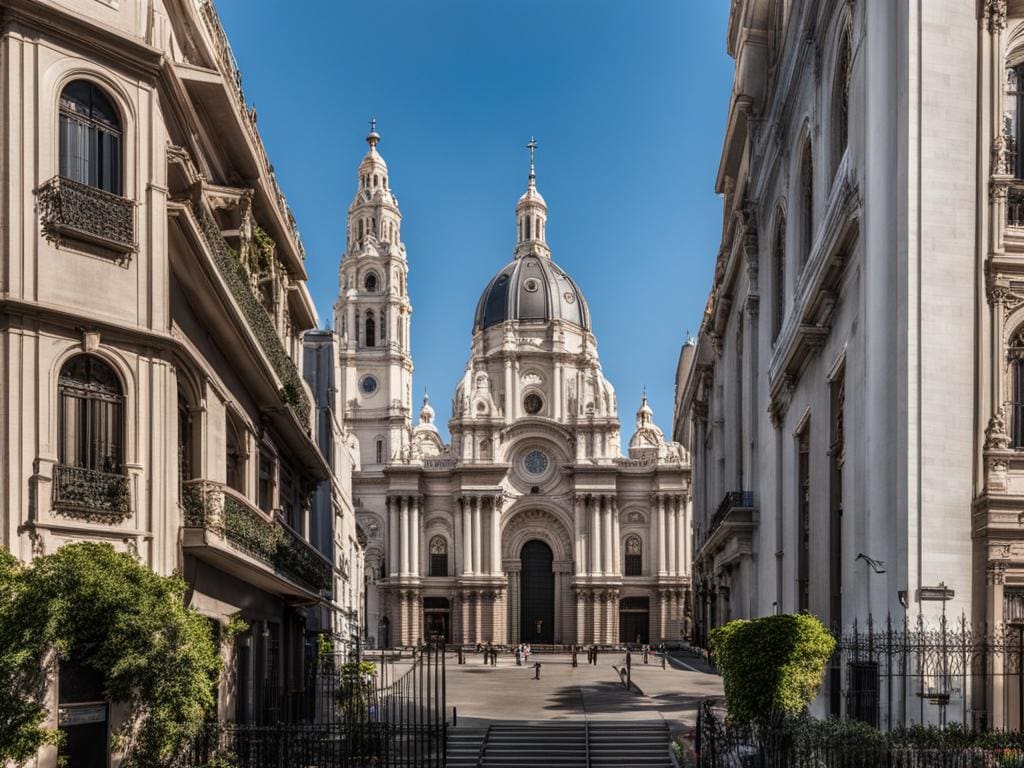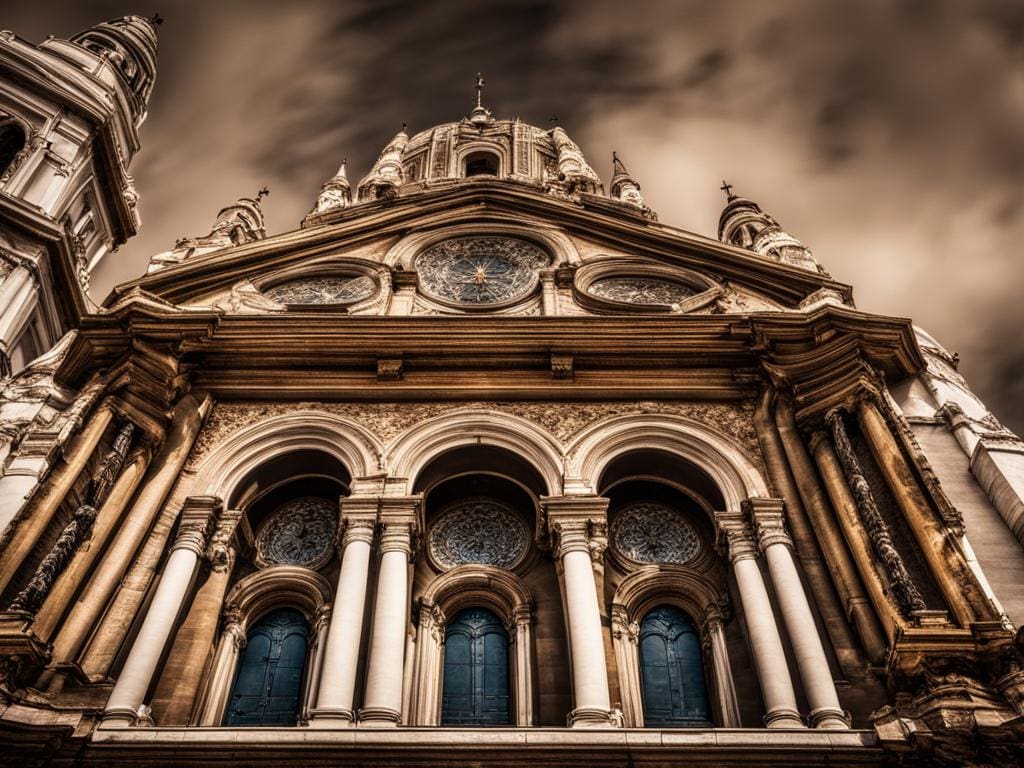Welcome to the Metropolitan Cathedral in Buenos Aires, Argentina. As the main Catholic church in the city, the Buenos Aires Metropolitan Cathedral holds significant religious and cultural importance. Located in the heart of Buenos Aires, overlooking the iconic Plaza de Mayo, this cathedral is a must-see attraction for both locals and tourists alike.
This stunning architectural masterpiece showcases a blend of styles from different periods, making it a true reflection of Buenos Aires’ rich history and diverse cultural influences. The Cathedral is not only a place of worship but also a symbol of national unity and a historical site that witnessed key moments in Argentina’s past.
Join us as we explore the fascinating history, captivating architecture, and cultural significance of the Buenos Aires Metropolitan Cathedral. Discover the beauty and spiritual significance of this iconic landmark that attracts visitors from all around the world.
Location and History of the Metropolitan Cathedral
The Buenos Aires Metropolitan Cathedral is located at the corner of San Martín and Rivadavia streets in the San Nicolás neighborhood of Buenos Aires. Situated in the city center, the cathedral overlooks the iconic Plaza de Mayo. The site has been home to various church structures since the 16th century, with the current building being a mix of architectural styles.
Construction of the cathedral began in 1752 and was not fully completed until the mid-19th century. Throughout its history, the cathedral has undergone several renovations and redesigns, resulting in its unique and eclectic architecture. The blend of styles includes elements of the 18th-century nave and dome, the 19th-century Neoclassical façade, and the incorporation of neo-Renaissance and neo-Baroque decorations in the interior.
With its rich history and architectural significance, the Buenos Aires Metropolitan Cathedral stands as a testament to the city’s religious and cultural heritage. Explore its captivating design and uncover the stories that have shaped this iconic religious site.
| Year | Event |
|---|---|
| 16th century | First church structure is established on the site |
| 1752 | Construction of the current cathedral begins |
| 19th century | Completion of the cathedral’s construction |
| 20th century | Renovations and redesigns to enhance the cathedral’s architecture |
Pope Francis and the Metropolitan Cathedral
Pope Francis, formerly known as Archbishop Jorge Bergoglio, was closely associated with the Buenos Aires Metropolitan Cathedral during his time as the Archbishop of Buenos Aires. This historic cathedral holds a special place in Pope Francis’ journey, as he used to hold mass and conduct religious ceremonies within its hallowed walls. Today, the Metropolitan Cathedral pays homage to its former Archbishop by housing the Pope Francis Museum, dedicated to showcasing personal objects and liturgical artifacts that were once used by the Pope. This unique connection to Pope Francis adds an extra layer of significance and allure to the Metropolitan Cathedral for visitors.
The Buenos Aires Metropolitan Cathedral’s association with Pope Francis also extends to its role as the site of significant events in his life. For instance, it was at this cathedral that Bergoglio celebrated his final mass as the Archbishop of Buenos Aires before ascending to the papacy. This event marked a pivotal moment in both the history of the cathedral and the Catholic Church as a whole.
Pope Francis Museum: A Glimpse into His Journey
The Pope Francis Museum located within the Metropolitan Cathedral provides visitors with a unique opportunity to delve deeper into the life and journey of Pope Francis. The museum showcases a collection of personal belongings, vestments, and liturgical objects used by the Pope during his time in Buenos Aires. Exhibits highlight significant moments and milestones in Pope Francis’ life and offer insight into his spiritual journey and the values he holds dear.
Paying Tribute to Pope Francis at the Metropolitan Cathedral
For many visitors, paying a visit to the Metropolitan Cathedral offers a chance to honor and connect with Pope Francis, a beloved figure who has captivated the world with his humility and compassion. The cathedral’s serene ambiance and its collection of artifacts associated with Pope Francis create a sense of reverence, inviting visitors to reflect on his teachings and the impact of his papacy.
Architecture and Design of the Cathedral
The Buenos Aires Metropolitan Cathedral is a testament to the rich architectural heritage of Buenos Aires. With its eclectic design and stunning details, the cathedral stands as a masterpiece of craftsmanship and artistic expression. The mix of architectural styles, resulting from the various renovations and reconstructions over the years, creates a unique charm that captivates visitors.
The 18th-century nave and dome, with their original architecture, showcase the cathedral’s historical roots. As you step inside, you’ll be greeted by a vibrant interior adorned with precious statues and altarpieces dating back to the 18th century. The neo-Renaissance and neo-Baroque decorations add to the grandeur and visual splendor of the cathedral.
The cathedral’s exterior is equally impressive. The 19th-century Neoclassical façade, characterized by its absence of towers, presents a striking contrast to the surrounding buildings. It is a testament to the evolution of architectural styles and the artistic vision of its creators. The combination of these architectural elements creates a harmonious blend of past and present, making the Buenos Aires Metropolitan Cathedral a true architectural gem.


Table: Architectural Features of the Buenos Aires Metropolitan Cathedral
| Architectural Style | Description |
|---|---|
| 18th-Century Nave and Dome | Retains original architecture, showcasing historical roots |
| 19th-Century Neoclassical Façade | Characterized by absence of towers, representing evolving architectural styles |
| Precious Statues and Altarpieces | 18th-century adornments depicting religious themes |
| Neo-Renaissance and Neo-Baroque Decorations | Elaborate designs adding grandeur to the interior |
The Historical Significance of the Cathedral
The Buenos Aires Metropolitan Cathedral holds a significant place in the history of Argentina. As the main Catholic church of Buenos Aires and the seat of the Archdiocese, it has witnessed pivotal moments in the country’s past. One notable event occurred in 1620 when Pope Paul V consecrated Buenos Aires as a bishopric within the walls of this majestic cathedral. This act marked the establishment of the city as an important religious center and laid the foundation for the growth of Catholicism in Argentina.
Also read about: Discovering Argentina’s Jewish Community: A Journey Through History and Culture
In addition to its religious significance, the Metropolitan Cathedral serves as a symbol of national unity. Within its walls, visitors can find the mausoleum of General José de San Martín, a revered figure in the fight for South American independence. This mausoleum, designed by renowned French sculptor Albert-Ernest Carrier-Belleuse, is a tribute to Argentina’s liberation and a reminder of the country’s historical legacy.
Table: Historical Events at the Buenos Aires Metropolitan Cathedral
| Year | Event |
|---|---|
| 1620 | Consecration of Buenos Aires as a bishopric by Pope Paul V |
| 1816 | Declaration of Argentine Independence |
| 1829 | Funeral of General José de San Martín |
| 1945 | Pope Francis’ baptism at the Metropolitan Cathedral |
Beyond its historical significance, the Buenos Aires Metropolitan Cathedral has become a popular destination for tourists seeking to explore the city’s religious sites. Its grandeur, rich architectural heritage, and cultural value make it a must-visit attraction for those interested in delving into the history and traditions of Buenos Aires. Whether admiring the intricate altarpieces and statues or paying respects at the mausoleum, visitors can’t help but be captivated by the cathedral’s timeless beauty and historical depth.
In the next section, we will take a closer look at the interior highlights of the Metropolitan Cathedral, delving into the exquisite art and design that awaits visitors within its sacred walls.
Interior Highlights of the Cathedral
The Buenos Aires Metropolitan Cathedral boasts a breathtaking interior that showcases the city’s rich artistic heritage and religious significance. Step inside and be mesmerized by the stunning architectural details and captivating artworks.
Rococo Altarpiece and Neo-Baroque Decorations
One of the highlights of the cathedral’s interior is the main gilt wood altarpiece, dating back to 1785, crafted in the Rococo style. The intricate carvings and golden embellishments create a majestic centerpiece that commands attention. Surrounding the altar, you’ll find exquisite neo-Baroque decorations, including ornate statues and intricate paintings, adding to the opulence and grandeur of the space.
Venetian-style Mosaics and Religious Symbols
As you explore the floors of the cathedral, you’ll notice the beautiful Venetian-style mosaics that adorn the pathways. These colorful mosaic designs depict various religious symbols, providing a visual representation of the cathedral’s spiritual significance. Take a moment to appreciate the craftsmanship and attention to detail that went into creating these intricate works of art.
Also read about: Discover the Liberty Temple in Buenos Aires
The Christ of Buenos Aires and Historical Statues
One of the most revered sculptures within the cathedral is the Christ of Buenos Aires, carved in 1671. This lifelike depiction of Christ on the cross is a symbol of faith and devotion for the local community. Additionally, the cathedral houses a collection of historical statues, including precious 18th-century sculptures and altarpieces. These statues offer a glimpse into the rich religious history and cultural heritage of Buenos Aires.
As you wander through the interior of the Buenos Aires Metropolitan Cathedral, you’ll be captivated by the harmonious blend of architectural styles, the intricate artwork, and the peaceful ambiance that permeates the space. It is a place of reverence, beauty, and spiritual reflection.
| Interior Highlights | Description |
|---|---|
| Rococo Altarpiece | The main gilt wood altarpiece, crafted in 1785, showcases intricate Rococo carvings and golden embellishments. |
| Neo-Baroque Decorations | Ornate statues and intricate paintings in the neo-Baroque style adorn the interior, adding to its opulence and grandeur. |
| Venetian-style Mosaics | Colorful mosaic designs inspired by Venetian artistry can be seen on the cathedral’s floors, depicting various religious symbols. |
| The Christ of Buenos Aires | A lifelike sculpture of Christ on the cross, carved in 1671, serves as a symbol of faith and devotion. |
| Historical Statues | Precious 18th-century statues and altarpieces showcase the rich religious history and cultural heritage of Buenos Aires. |


Buenos Aires Metropolitan Cathedral: The Mausoleum of General San Martín
Nestled within the Buenos Aires Metropolitan Cathedral is the remarkable mausoleum of General José de San Martín, an iconic figure in the fight for South American independence. This mausoleum serves as a poignant tribute to Argentina’s historic legacy and the brave individuals who fought for liberation.
Designed by renowned French sculptor Albert-Ernest Carrier-Belleuse, the mausoleum is a testament to architectural grandeur and artistic craftsmanship. It houses the remains of General San Martín, as well as those of other notable individuals who played significant roles in Argentina’s history. The mausoleum stands as a symbol of national pride and honor, drawing visitors from near and far to pay their respects.
Also read about: Recoleta Cemetery in Buenos Aires
As you explore the Buenos Aires Metropolitan Cathedral, the mausoleum of General San Martín captivates with its intricate details and solemn atmosphere. It is a site that invites reflection on the sacrifices made for freedom and the enduring legacy of those who shaped Argentina’s destiny.
| Key Features of the Mausoleum |
|---|
| Architectural Design |
| The mausoleum showcases exceptional architectural design, marrying elements of neoclassical style with intricate sculptural details. The craftsmanship and attention to detail create a visually stunning tribute to General San Martín and the ideals he championed. |
| Symbolic Significance |
| Located within the Metropolitan Cathedral, the mausoleum serves as a symbol of Argentina’s struggle for independence and the values that General San Martín embodied. It stands as a powerful reminder of the country’s history and the enduring spirit of its people. |
| National Heritage |
| The mausoleum is a cherished part of Argentina’s national heritage, representing the sacrifices and contributions of its heroes. It holds a special place in the hearts of Argentinians and serves as a pilgrimage site for those seeking to connect with the country’s storied past. |
Visiting the mausoleum of General San Martín within the Buenos Aires Metropolitan Cathedral is a moving and meaningful experience. It offers a glimpse into Argentina’s history and provides an opportunity to pay tribute to the individuals who shaped the nation’s destiny. This spiritual and culturally significant site is a must-see when exploring Buenos Aires.
Unique Features of the Cathedral
The Buenos Aires Metropolitan Cathedral is not only known for its rich history and stunning architecture but also for its unique features that make it a truly remarkable attraction in Buenos Aires. From a statue dedicated to the world of football to a memorial for the victims of tragic events, the cathedral offers visitors a glimpse into the diverse and meaningful aspects of Argentine culture and history.
Christ of Footballers
One of the distinctive features of the Metropolitan Cathedral is the presence of the “Christ of Footballers” statue. This statue, donated by an Argentine soccer player in 1978, holds a special place in the hearts of both locals and sports enthusiasts. It symbolizes the deep connection between religion and football, which is often considered a national obsession in Argentina. The statue serves as a reminder of the country’s passion for the beautiful game and the role it plays in the lives of many.
Mausoleum of General San Martín
Inside the cathedral, you will find the mausoleum of General José de San Martín, a key figure in the fight for South American independence. Designed by French sculptor Albert-Ernest Carrier-Belleuse, the mausoleum houses the remains of San Martín, as well as those of other notable individuals. This solemn and historically significant site invites visitors to pay tribute to Argentina’s liberation and reflect on the country’s journey to independence.
Memorial to Tragic Events
In addition to its religious and historical significance, the Metropolitan Cathedral also serves as a memorial for the victims of the Holocaust and the bombings in Buenos Aires in the 1990s. These memorials stand as powerful reminders of the tragic events that have shaped Argentina’s history and serve as a testament to the resilience and strength of the Argentine people.
Visiting the Buenos Aires Metropolitan Cathedral is not only a chance to admire its architectural beauty and explore its rich history but also an opportunity to experience the unique features that make it a truly exceptional place. From the “Christ of Footballers” statue to the mausoleum of General San Martín and the memorials for tragic events, every aspect of the cathedral contributes to its significance in the hearts and minds of both locals and visitors alike.
Conclusion
The Buenos Aires Metropolitan Cathedral is a must-visit attraction in Buenos Aires, offering a unique blend of history, architecture, and religious significance. Located in the heart of the city, this iconic cathedral serves as the main Catholic church in Buenos Aires and the mother church of the Archdiocese of Buenos Aires.
With its stunning architecture and rich history, the Metropolitan Cathedral is a true masterpiece. From its eclectic mix of architectural styles to its ornate interior adorned with precious statues and altarpieces, the cathedral provides a visually captivating experience for visitors.
Additionally, the cathedral’s connection to Pope Francis adds to its appeal. As the former Archbishop of Buenos Aires, Pope Francis used to hold mass at the Metropolitan Cathedral. Today, the cathedral houses the Pope Francis Museum, showcasing some of his personal and liturgical objects.
Whether you are a history enthusiast, an architecture admirer, or a religious pilgrim, a visit to the Buenos Aires Metropolitan Cathedral is a must. Immerse yourself in the rich cultural heritage of Buenos Aires and explore this iconic symbol of the city’s faith and history.
FAQ
Where is the Buenos Aires Metropolitan Cathedral located?
The cathedral is located at the corner of San Martín and Rivadavia streets in the San Nicolás neighborhood of Buenos Aires.
What is the history of the Metropolitan Cathedral?
The site has been home to various church structures since the 16th century, with the current building being a mix of architectural styles. Construction began in 1752 and was completed in the mid-19th century.
Is the Metropolitan Cathedral connected to Pope Francis?
Yes, Pope Francis, formerly known as Archbishop Jorge Bergoglio, used to hold mass at the Metropolitan Cathedral before becoming the Pope. The cathedral now houses the Pope Francis Museum.
What architectural styles are featured in the Metropolitan Cathedral?
The cathedral boasts a mix of architectural styles due to various renovations throughout its history. The 18th-century nave and dome maintain their original architecture, while the 19th-century façade is Neoclassical.
What is the significance of the Metropolitan Cathedral in Argentina’s history?
The cathedral has witnessed important moments in Argentina’s history, including the consecration of Buenos Aires as a bishopric in 1620. It also houses the remains of General José de San Martín and the mausoleum of the Unknown Soldier of Argentine Independence.
What can visitors expect to see inside the Metropolitan Cathedral?
The interior features a Latin cross layout with three aisles and side chapels. It is adorned with 18th-century statues, altarpieces, and neo-Renaissance and neo-Baroque decorations. The cathedral’s ornate design offers a visually captivating experience.
What is the significance of the mausoleum in the Metropolitan Cathedral?
The mausoleum of General José de San Martín is located in the cathedral. It was designed by French sculptor Albert-Ernest Carrier-Belleuse and contains the remains of San Martín and other notable individuals.
What unique features does the Metropolitan Cathedral have?
The cathedral is home to the image of the Christ of Footballers and a memorial to the victims of the Holocaust and bombings in Buenos Aires. It also houses the renowned 1871 Walcker organ.
Why should I visit the Buenos Aires Metropolitan Cathedral?
The cathedral offers a unique blend of history, architecture, and religious significance. Its connection to Pope Francis, stunning interior design, and cultural importance make it an iconic symbol of Buenos Aires.




